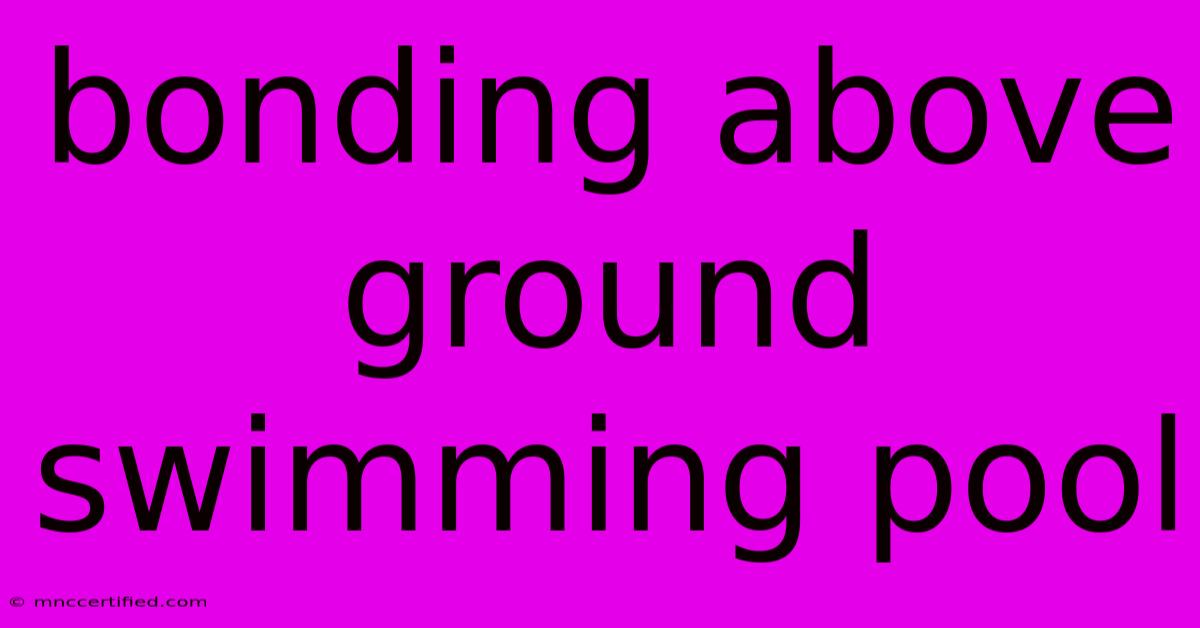Bonding Above Ground Swimming Pool

Table of Contents
Bonding Your Above Ground Pool: A Guide to Safety and Longevity
Owning an above ground pool is a fantastic way to enjoy summer fun and create lasting memories with family and friends. But, did you know that proper bonding is crucial for ensuring your pool's safety and longevity?
This comprehensive guide will explain everything you need to know about bonding your above ground pool, from the basics to the best practices. We'll cover:
- Why is bonding important?
- What needs to be bonded?
- How to bond your above ground pool?
- Tips for successful bonding
- Common bonding mistakes to avoid
The Importance of Pool Bonding: Protecting You and Your Pool
Pool bonding is a vital safety measure that helps prevent electric shock by providing a safe path for electricity to flow in the event of a fault. Without proper bonding, electricity can travel through the water and metal components of your pool, creating a serious hazard for anyone in the water.
What Needs to Be Bonded?
The following components of your above ground pool should be bonded together:
- Metal pool structure: The entire pool frame, including the top rails, ladders, and handrails.
- Electrical equipment: This includes the pump, filter, heater, and any other electrical components connected to the pool system.
- Metal fittings: All metal pipes, valves, and fittings that connect to the pool system.
- Surrounding metal surfaces: Metal fences, gates, and other objects within a specified distance of the pool should also be bonded.
How to Bond Your Above Ground Pool
-
Gather your materials: You'll need:
- Bonding wire: Use at least 6 AWG copper bonding wire.
- Bonding clamps: Choose clamps suitable for the size of the wire and the components you're bonding.
- Grounding rod: A properly installed grounding rod is crucial for effective bonding.
- Electrical tape: For insulating connections.
- Wire cutters and strippers: For preparing the wire.
-
Locate the grounding rod: The grounding rod should be driven into the ground at least 8 feet deep and ideally away from the pool and any electrical lines.
-
Connect the bonding wire to the grounding rod: Use a bonding clamp to securely attach one end of the bonding wire to the grounding rod.
-
Connect the bonding wire to the metal pool structure: Start at the pool frame and run the bonding wire along its length, attaching it to the metal components using bonding clamps at intervals of no more than 10 feet.
-
Bond electrical equipment: Connect bonding wire to the metal components of each piece of electrical equipment, making sure to bond the wire to the equipment's ground terminal.
-
Bond metal fittings: Connect bonding wire to any metal pipes, valves, and fittings using bonding clamps.
-
Bond surrounding metal surfaces: Run bonding wire from the pool frame to any metal fences, gates, or other surfaces within a specified distance of the pool, using bonding clamps to secure the connection.
-
Verify your work: Once you've completed the bonding process, it's important to have a qualified electrician verify your work to ensure it meets all local electrical codes and is properly connected.
Tips for Successful Bonding
- Use high-quality bonding wire and clamps.
- Ensure all connections are tight and secure.
- Keep bonding wire connections above ground level.
- Use electrical tape to insulate connections.
- Regularly inspect your bonding system for corrosion and damage.
Common Bonding Mistakes to Avoid
- Using insufficient wire size: Too small a wire can lead to overheating and potential failure.
- Not bonding all required components: Leaving any metal components unbonded creates a potential safety hazard.
- Improper connection: Loose connections can result in a faulty bond.
- Neglecting regular inspection: Corrosion and damage can weaken bonding connections over time.
Conclusion: Bonding for Safety and Peace of Mind
Bonding your above ground pool is an essential step in ensuring both your safety and the longevity of your pool. By following these guidelines, you can create a safe and enjoyable swimming environment for everyone. Remember to have your work inspected by a qualified electrician to ensure it meets all safety standards.

Thank you for visiting our website wich cover about Bonding Above Ground Swimming Pool. We hope the information provided has been useful to you. Feel free to contact us if you have any questions or need further assistance. See you next time and dont miss to bookmark.
Featured Posts
-
Covalent Bonding Worksheet Answers
Nov 15, 2024
-
England Rugby London Lineup
Nov 15, 2024
-
Venezuela Vs Brazil Live Stream World Cup Guide
Nov 15, 2024
-
How Much Is 8800 Yen In Us Dollars
Nov 15, 2024
-
Trump Appoints Kennedy Jr To Hhs Role
Nov 15, 2024